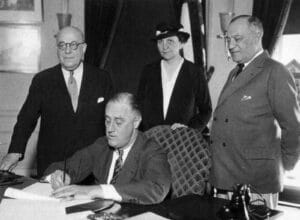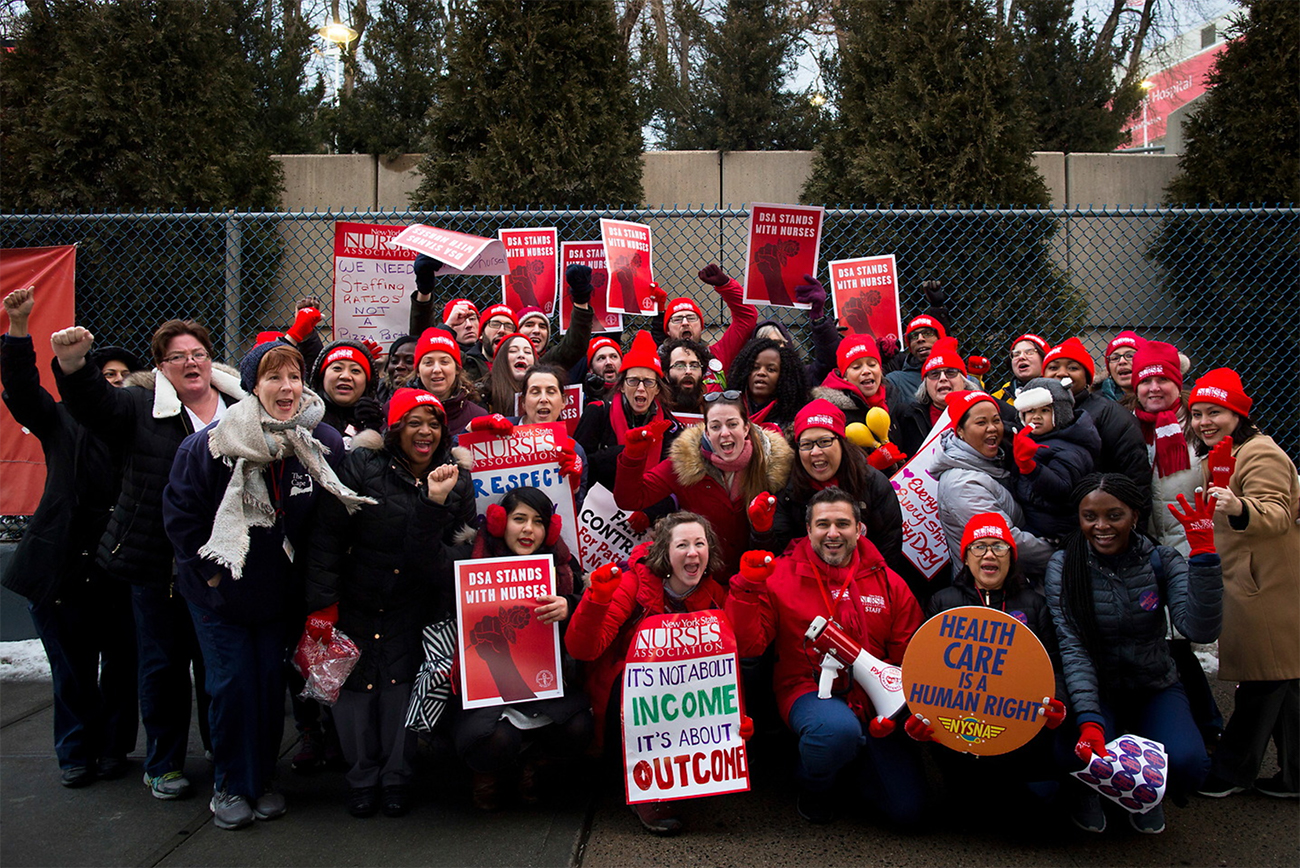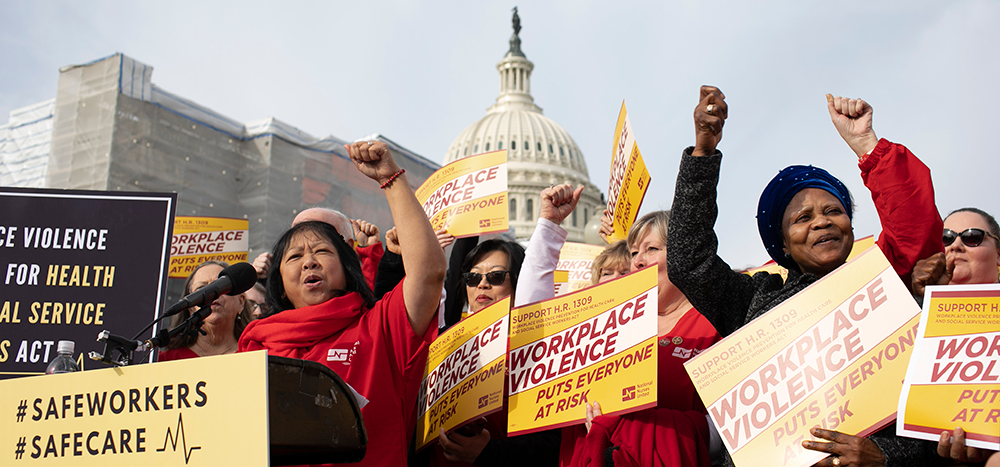Whether to join a nurse union or not has been a dividing question in nursing since labor across the world started to unionize from the early 1900s. While in the United States, union membership is shrinking in most sectors, the number of nurses joining unions or organizing to form unions is increasing.
Many nurses see unions, and what they stand for, as unprofessional and against their ethical code. Other nurses believe that collective bargaining through unionization is the only way to address current issues in nursing, such as staff shortages, and their effect on the care which nurses can provide to their patients.
Joining a union has professional, ethical, personal and financial implications and every nurse should be able to make their own informed decision. Your stance on unions can, for example, influence where you apply for a job once you qualify – you might have to join the union at a particular hospital, whether you want to or not.
This article will provide you with some background about unions and unionization in nursing, and explain what unions do.
Table of Contents
- What is a Union?
- Unionization in Nursing
- Nurse Unions in the US
- Nurses’ Rights to Unionize
- Pros and Cons of Nurse Unions
- Nurse Unions and Lobbying for Legislative Changes
- Should I Join a Nurse Union?
- References and Sources
What is a Union?
With increased industrialization in the early 1900s, and business owners only interested in profits, there was extreme exploitation and often inhumane treatment of the labor force. Workers realized that they needed to stand together and speak with one voice – bargain collectively – to confront management and to improve their wages and working conditions.
Clashes between workers and management often became violent and over time governments stepped in to regulate worker’s rights. In the US, the National Labor Relations Act, providing for workers’ right to unionize, was passed in 1935.

The legislation initially excluded public sector employees, and at times also those working for non-profit organizations. In the US today, employees can only get union representation if the employer voluntarily recognizes the union or when the majority of employees vote for unionization. Under labor law, the voting process is monitored and conducted by the National Labor Relations Board. Any coercion tactics, on either side, to influence employees to vote one way or another are illegal.
Besides regulating the recognition of unions by management, the legislation also spells out the processes which must be followed in collective bargaining. The most forceful bargaining tool is strike action – but this leverage is usually used only as a last resort.
In addition, the Taft-Hartly Act, passed in 1947, provides for either right-to-work or non-right-to-work states in the US. In the 26 right-to-work states, employees can work at a unionized facility without having to join the union. In the other states, persons working at unionized facilities have to be paying members of the union – whether they want to or not.
Today most companies accept that it is in their own interests to provide fair conditions of service for their employees. As a result, union membership has been dropping steadily. According to the US Bureau of Labor Statistics, only 10.5% of workers belonged to unions in 2018, down from 20.1% in 1983.
In contrast, the number of nurses who are members of unions has been increasing steadily. Currently, about 21% of nurses in the US belong to a union.
Unionization in Nursing
The drive for unionization in the last century came at a time when nursing organizations across the world were advocating for recognition of nursing as a profession. Unions were for laborers and those in trades – professionals generally did not join unions. Furthermore, union tactics were viewed as being in conflict with the values of nursing.

Since then there have been many changes in society and in the professions. For example, whereas professionals in the early 1900s were usually self-employed most are now salaried employees. As a result, there has also been a significant shift in the attitudes of nursing organizations towards unionization and collective bargaining.

The Irish Nurses and Midwives Organisation (INMO) was founded in 1919 as the first trade union for hospital nurses in the world and is celebrating its centenary this year. At the time a commentator in The Irish Times, while acknowledging that nurses needed a better deal, wrote that nurses “were about to ‘cheapen the magnificent repute this profession has won for itself” and compared a strike of nurses to a strike of wives.”
The Royal College of Nursing in the United Kingdom, founded in 1916, registered as a trade union in 1976. Initially, it didn’t support strikes by nurses but this provision was changed in 1995, allowing for industrial action as long as it did not harm patients. Today it is the largest union for nursing staff in the world, while still undertaking the professional development activities of a professional organization.
Nurse Unions in the US
The American Nursing Association (ANA) entered the arena of collective bargaining in 1950. It realized that its members needed support with issues around wages, working hours and conditions of employment – and they also wanted to prevent nurses from joining unions.
Initially, the ANA had a no-strike policy, but it was removed in 1968. This was after strikes had been organized by general unions representing nurses and also some ANA affiliated state nursing associations, who had started to act more like unions. In 1999 the ANA formed United American Nurses (UAN) to separate union activity from its professional development functions.

National Nurses United (NNU) was created in 2009 when the state nursing associations of California and Massachusetts disassociated from the ANA to combine with the UAN. Today NNU is the largest nursing union in the US, although there are many different unions representing nurses in this country.
Nurses’ Rights to Unionize
In 1999 the International Council of Nurses (ICN) adopted a policy statement on industrial action by nurses. The document affirms nurses’ right to collective bargaining and industrial action. It acknowledges that in some circumstances strike action might be necessary to ensure quality patient care for the future. Industrial action should, however, only be used as a last resort and the general public must always be provided with essential services.
Organized nursing therefore now recognizes the right of nurses to embark on industrial action and more-and-more nurses are choosing to unionize. Furthermore, over the past few years, we have witnessed an increased number of strikes by nurses across the world. Most nursing strikes make international news headlines because of its impact on the community.
Compared to strikes in other sectors, recent strikes by nurses have not been primarily about improved salaries. They have focused mostly on issues that affect safe patient care – for example, staff shortages, nurse-patient ratios, and compulsory overtime. And these issues can be related directly to current developments in the health care industry, including budget cuts and ever-increasing focus on profits.
However, nurses everywhere are still divided on the question of whether abandoning their patients in the event of a strike is compatible with the ethics and standards of their profession. This has been known to cause disagreements and conflict even among colleagues in the workplace.
Pros and Cons of Nurse Unions
Unions use their collective voice to bargain for improved compensation and conditions of service. Here are the pros and cons of nurse unions:
It’s reported that nurses in the US who work in facilities that are unionized earn up to 18% more than non-unionized nurses. In some cases, unions have also succeeded in areas such as obtaining higher pay for the unpopular shifts.
In considering income you should, however, also realize that you’ll have to pay monthly union dues and that in the event of strike action you will lose the income for the days you’re on strike.
Union negotiated salaries mean guaranteed wages and pay increases, based on years of service and other standards. The downside is that it could limit the possibilities of advancement on the grounds of excellent performance if you are not the most senior person in line for a promotion.
The contract which you’ll sign when joining a unionized facility will reflect the agreements which the union has negotiated with the particular employer. This might include a reference to higher compensation for particular types of work, exclusion of mandatory overtime, nurse-patient ratios, rules for floating, and a nurse’s right to refuse assignments for which they don’t feel adequately prepared. Employer provisions for continuing education could even be included. The contracts in a non-union facility might not make provision for any of the abovementioned employment benefits.
At unionized workplaces, grievance procedures are clearly spelled out. Furthermore, union members are represented by the union in any dispute or disciplinary proceeding. This ensures fair treatment and protects employees from retaliation and victimization.
This can, however, draw out and complicate minor clashes as the union has to mediate in every incident. While protecting members from arbitrary or unfair dismissal, unions can also make it very difficult for employers to get rid of incompetent employees, or even those suspected of misconduct.
A good example of this became evident during the hearing of Elizabeth Wettlaufer’s serial killings of patients in long-term care homes. An administrator testified that the union made it difficult to reprimand or terminate Wettlaufer for various incidents of misconduct. In the end, it was simpler and cheaper not to fight the union and to just issue warnings instead. When Wettlaufer was eventually terminated the union intervened for the records to show voluntary resignation.
Nurse Unions and Lobbying for Legislative Changes
Nurse unions are also active in using their collective voice to advocate for changes in the laws that regulate hospitals and other health care facilities, whether at the state or federal level. One of the reasons why an increasing number of nurses in the US are joining unions, and for protests and strikes by nurses, is the current lobby for legislation to provide for minimum nurse-patient ratios. Other current issues that unions are addressing at the highest levels include mandatory overtime and the safety of nurses in the light of the increasing violence against nurses.
Should I Join a Nurse Union?
To answer this question you should arm yourself with as much knowledge as possible and then, within your own frame of reference, weigh up whether joining a union is in line with your personal and professional values. You should also consider the practical costs and benefits of joining a union and investigate what different unions have to offer.
You will then be in a position to make an informed personal choice on whether you want to join a union or not and/or are prepared to accept a job at a facility where you have to join.
References and Sources
Recommended references and journal articles about nurse unions:
- Higgins, Christina, “Nursing Education: Unions and their Place in the Curriculum” (2016). Master of Arts/Science in Nursing Scholarly Projects. 97. [View Source]
- Seago, J. A., & Ash, M. (2002). Registered nurse unions and patient outcomes. JONA: The Journal of Nursing Administration, 32(3), 143-151. [View Source]
- Seago, J. A., Spetz, J., Ash, M., Herrera, C. N., & Keane, D. (2011). Hospital RN job satisfaction and nurse unions. JONA: The Journal of Nursing Administration, 41(3), 109-114. [View Source]
